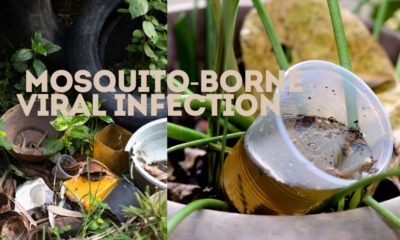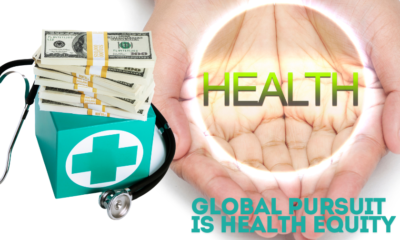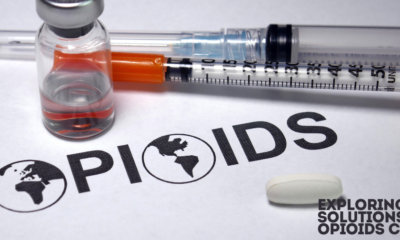Public Health
Understanding Waterborne Diseases: Prevention and Treatment Strategies

Waterborne diseases primarily spread through drinking or using contaminated water. Contamination can occur from a variety of sources, including human and animal waste, agricultural runoff, and poorly managed water treatment systems. Common pathogens include bacteria (such as Escherichia coli and Vibrio cholerae), viruses (like norovirus and hepatitis A), and protozoa (such as Giardia and Cryptosporidium).
The World Health Organization (WHO) emphasizes that safe drinking water, sanitation, and hygiene (WASH) are fundamental to preventing waterborne diseases. Contaminated water affects human health through direct consumption or through contact during bathing, food preparation, or recreational activities. The burden of waterborne diseases disproportionately affects low-income countries with limited access to safe water and adequate sanitation.
Current Trends and Statistics
Waterborne diseases contribute significantly to global morbidity and mortality rates. According to the WHO, diarrheal diseases resulting from inadequate WASH conditions cause more than 1 million deaths annually, predominantly affecting children under five years old in developing countries. These deaths are preventable with improved water quality, sanitation, and hygiene interventions.
In the United States, the Centers for Disease Control and Prevention (CDC) reports that waterborne diseases are still a significant health threat, particularly with the emergence of complex water systems in buildings such as hospitals, hotels, and recreational facilities. The CDC’s Waterborne Disease and Outbreak Surveillance System (WBDOSS) has tracked such outbreaks for decades, providing data that guide regulatory measures and public health initiatives.
Prevention Strategies
1) Safe Water Supply and Sanitation:
Improving access to safe drinking water is the most effective measure to prevent waterborne diseases. This involves providing clean water sources and ensuring proper sanitation systems to prevent contamination. The WHO recommends regulated piped water, adequate sewage connections with wastewater treatment, and routine water quality surveillance to reduce the risk of waterborne diseases dramatically.
2) Water Management in Buildings and Facilities:
Water management programs are crucial for large buildings like healthcare facilities and hotels to prevent the growth of waterborne pathogens, such as Legionella. The CDC highlights the importance of maintaining water systems to prevent the formation of slimy biofilm layers that can harbor pathogens and regularly disinfecting water supplies to keep them safe for use. The CDC also provides toolkits for building managers to create and implement effective water management programs.
3) Public Education and Awareness:
Raising public awareness about waterborne diseases and preventive measures is essential. Public health campaigns should focus on educating communities about safe water handling practices, proper hand hygiene, and safe food preparation techniques to reduce the risk of infection. To enhance prevention efforts, the WHO promotes integrating WASH education into other health programs, such as cholera and neglected tropical diseases (NTDs).
4) Surveillance and Outbreak Response:
Effective surveillance systems, such as the CDC’s WBDOSS and the National Outbreak Reporting System (NORS), play a crucial role in detecting and responding to waterborne disease outbreaks. These systems help track the epidemiological patterns of diseases, provide data for targeted interventions, and inform policy-making for water safety standards. Public health officials are trained to investigate outbreaks and implement control measures to prevent further spread.
Treatment Strategies
1) Rehydration Therapy:
The primary treatment for waterborne diseases, especially diarrheal illnesses, is rehydration. Oral Rehydration Salts (ORS) and intravenous fluids are essential for managing dehydration caused by diseases like cholera and rotavirus. The WHO and UNICEF promote the use of ORS as a cost-effective and life-saving intervention in both community and clinical settings.
2) Antimicrobial Therapy:
In cases where bacterial infections such as typhoid fever or severe dysentery are identified, antibiotics are prescribed based on sensitivity patterns. However, the rise of antibiotic resistance among waterborne pathogens poses a growing challenge. Thus, antimicrobial stewardship and proper diagnostic procedures are crucial for effective treatment.
3) Antiparasitic and Antiviral Treatments:
Specific waterborne diseases, such as cryptosporidiosis and giardiasis, caused by protozoan parasites, require anti-parasitic medications like nitazoxanide or metronidazole. Similarly, hepatitis A, caused by viral contamination of water, can be prevented by vaccination and supportive care if infection occurs.
Global and Local Initiatives
Global organizations, including the WHO, UNICEF, and WaterAid, are working towards improving access to safe water and sanitation as part of the Sustainable Development Goals (SDGs), particularly SDG 6, which aims to ensure the availability and sustainable management of water and sanitation for all by 2030. These organizations provide technical support, advocate for effective policies, and engage in capacity-building efforts in countries where WASH-related diseases are most prevalent.
At a national level, agencies like the CDC in the U.S. continue to provide critical surveillance, data collection, and public health guidelines to manage and prevent waterborne diseases. In addition, these agencies work with local governments and organizations to implement water safety plans and promote research on emerging pathogens and water safety technologies.
Global and Local Initiatives for Improving Access to Clean Water: Impact and Strategies
Safe and clean water access is fundamental for health, economic development, and social stability. Despite significant progress in recent decades, billions of people worldwide still lack reliable access to safe drinking water, proper sanitation, and hygiene services. Addressing this challenge requires a multi-faceted approach involving global and local initiatives that focus on infrastructure development, community engagement, policy advocacy, and innovative technologies. Here is an expanded discussion of some of the most impactful global and local initiatives, their strategies, and their effects on improving access to clean water.
1) Global Initiatives: Coordinated Efforts for Universal Access
Global organizations, such as the World Health Organization (WHO), United Nations Children’s Fund (UNICEF), WaterAid, and the World Bank, have been at the forefront of initiatives aimed at providing universal access to safe water and sanitation. These initiatives are aligned with the United Nations’ Sustainable Development Goal (SDG) 6, which aims to “ensure availability and sustainable management of water and sanitation for all” by 2030.
2) WHO and UNICEF’s Joint Monitoring Programme (JMP) for Water Supply, Sanitation, and Hygiene
The JMP, established in 1990 by WHO and UNICEF, plays a critical role in monitoring global progress towards SDG 6. The JMP provides data on the proportion of the population using safely managed drinking water and sanitation services, helping governments and organizations target interventions where they are needed most.
- Impact: The data provided by the JMP has led to targeted investments and policy reforms in countries lagging in WASH services. For example, JMP data has been crucial in guiding interventions in sub-Saharan Africa and South Asia, regions with some of the lowest rates of access to safe water and sanitation.
WaterAid: Community-Based Solutions
WaterAid is an international non-profit organization dedicated to improving access to clean water, decent toilets, and good hygiene in the world’s poorest communities. WaterAid focuses on long-term, community-led solutions, such as rainwater harvesting systems, solar-powered water pumps, and sanitation facilities that are environmentally sustainable.
- Impact: WaterAid has directly impacted the lives of millions of people. For instance, WaterAid has helped provide clean water to over 1.2 million people in Ethiopia through boreholes, spring capping, and water distribution networks. By involving communities in the planning, management, and maintenance of these systems, WaterAid ensures the sustainability of its interventions.
World Bank’s Water Global Practice
The World Bank’s Water Global Practice focuses on financing large-scale infrastructure projects to improve water supply and sanitation in developing countries. It combines technical expertise with financial resources to help countries develop sustainable water management systems.
- Impact: The World Bank has invested billions of dollars in WASH projects globally. For example, India’s Punjab Rural Water Supply and Sanitation Project benefited 1.6 million people by improving water quality and sanitation services. The project emphasized decentralized service delivery models and built capacity at the local government level, thereby ensuring sustainable water management.
Global Water Partnership (GWP)
The GWP is an international network that promotes Integrated Water Resources Management (IWRM) to ensure the sustainable use and management of water resources worldwide. GWP works with countries to implement policies that integrate water management across sectors such as agriculture, industry, and urban development.
- Impact: GWP has facilitated numerous national water management plans, helping countries like Rwanda and Nepal develop comprehensive strategies to manage their water resources sustainably. In Rwanda, GWP’s support has led to the adoption of policies that prioritize water access in national development plans, significantly improving water supply resilience amid climate change challenges.
Local Initiatives: Ground-Level Impact and Community Engagement
Local governments, community organizations, and non-governmental organizations (NGOs) play a crucial role in improving access to clean water. Their initiatives often involve direct community engagement, local capacity building, and the implementation of context-specific solutions.
Local Government Water Safety Plans
Many countries are now implementing Water Safety Plans (WSPs) at the local level. These plans are comprehensive risk assessment and management approaches that cover all stages of a water supply system from catchment to consumer. The WHO supports these plans, which are tailored to local contexts and are designed to ensure water safety by preventing contamination at the source, during distribution, and at points of use.
- Impact: In countries like Uganda and Vietnam, the implementation of WSPs has led to significant reductions in waterborne diseases. By involving local communities in the monitoring and management of water quality, these plans have empowered local stakeholders and improved the sustainability of water safety measures.
Community-Led Total Sanitation (CLTS) Programs
Community-Led Total Sanitation (CLTS) is an innovative approach that mobilizes communities to eliminate open defecation and adopt safe sanitation practices. Developed in Bangladesh, CLTS has been widely adopted across Asia, Africa, and Latin America.
- Impact: CLTS has led to significant behavior changes in communities, reducing the prevalence of waterborne diseases such as diarrhea. For example, in Nigeria, CLTS has been instrumental in achieving Open Defecation Free (ODF) status in many rural areas, improving overall community health outcomes.
Safe Water Network Initiatives
Safe Water Network, a non-profit organization, focuses on developing locally owned and operated water stations, particularly in Ghana and India. These water stations provide affordable, clean water to underserved communities and use a business model that ensures long-term sustainability.
- Impact: In Ghana, Safe Water Network has improved access to clean water for over 1.4 million people through more than 200 water stations. The initiative ensures sustainability and community ownership by training local entrepreneurs and community members to manage and maintain these stations.
Rainwater Harvesting and Decentralized Water Systems
In many regions facing water scarcity, local governments and NGOs are promoting rainwater harvesting and decentralized water systems as sustainable solutions. These systems capture and store rainwater for household use, reducing dependence on unreliable municipal supplies and groundwater sources.
- Impact: In India, rainwater harvesting has become crucial to rural and urban water management strategies. States like Rajasthan and Tamil Nadu have made significant strides in water conservation by implementing mandatory rainwater harvesting policies, leading to improved groundwater recharge and reduced water scarcity during dry seasons.
Impact on Health, Social, and Economic Development
The impact of these global and local initiatives on improving access to clean water extends beyond health outcomes. Access to safe water and sanitation also contributes to economic development and social stability:
Health Benefits: Reduced incidence of waterborne diseases such as cholera, diarrhea, and typhoid fever significantly lowers mortality rates, particularly among children under five. This improves overall public health and reduces the burden on healthcare systems.
Economic Gains: Clean water access reduces the time women and children spend fetching water, enabling them to engage in educational and financial activities. According to the WHO, every dollar invested in clean water and sanitation yields a $4 return through improved health, increased productivity, and reduced healthcare costs.
Social Empowerment: Improved access to water and sanitation facilities promotes gender equity by freeing women and girls from the laborious task of water collection, allowing them to pursue education and economic opportunities.
Conclusion
Preventing and treating waterborne diseases require a multi-faceted approach that combines safe water supply and sanitation, effective water management, public education, robust surveillance systems, and appropriate medical treatments. As climate change, urbanization, and population growth continue to challenge water safety worldwide, strengthening these strategies will be essential to reduce the burden of waterborne diseases and protect public health.
-

 Home and Garden6 days ago
Home and Garden6 days agoTransform Your Space: A Guide to Minimalist House Interior Design in 2025
-

 Home & Family6 days ago
Home & Family6 days ago10 Essential Cleaning Hacks for Bathroom Surfaces You Need to Try
-

 Health & Fitness6 days ago
Health & Fitness6 days agoDiscovering the Best Multivitamin for Women Over 40: Essential Nutrients for Optimal Health
-

 Automotive5 days ago
Automotive5 days agoUnlocking Performance: Why the HP Spectre x360 is the Ultimate 2-in-1 Laptop for 2025
-

 Health & Fitness6 days ago
Health & Fitness6 days agoDiscover the Best Multivitamin for Women Over 40: A Comprehensive Guide to Optimal Health
-

 Crime6 days ago
Crime6 days agoExploring the Most Anticipated New True Crime Documentaries of 2025
-

 Business6 days ago
Business6 days agoMaximize Your Earnings with American Express High Yield Savings Accounts in 2025
-

 Gadgets & Electronics5 days ago
Gadgets & Electronics5 days agoTop 5 Unlocked Android Phones Under $100 for Budget Shoppers in 2025





































